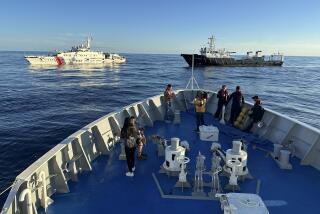Philippine Guerrilla’s Body Sought
- Share via
WASHINGTON — WASHINGTON -- Philippine fishermen and soldiers searched today off the coast of Mindanao island for the body of rebel leader Abu Sabaya, who was reportedly killed Friday in a gun battle with Philippine commandos.
President Bush applauded Sabaya’s death and Pentagon officials here said Friday that their deployment of more than 1,000 U.S. troops to the Philippines to train soldiers had paid off during Friday’s clash.
The Philippine government announced a reward of $1,000 for the recovery of Sabaya’s body, which is presumed to have sunk with those of two other rebels believed killed in the early-morning gunfight at sea.
Philippine military officials acknowledged that the body--and absolute proof of Sabaya’s death--might elude them. The battle took place in shark-infested waters nearly a mile from shore where the currents are strong and the water is about 1,500 feet deep. Sabaya presumably was weighed down with ammunition and heavy boots.
Four members of the Abu Sayyaf rebel group who were arrested during the clash were identified by former hostages as being among Sabaya’s inner circle. One soldier reported shooting Sabaya from a distance of three feet.
Sunglasses like the ones Sabaya usually wore and a satellite phone were found among the wreckage of the boat. Sabaya was known for calling radio stations from a satellite telephone and taunting Philippine President Gloria Macapagal Arroyo.
The U.S. has offered a reward of as much as $5 million for the capture or killing of Abu Sayyaf leaders, including Sabaya. It was unclear how the reward money might be parceled out with the report of his death.
Bush praised Arroyo for the government’s campaign against the Abu Sayyaf and the apparent death of Sabaya, saying she “did the world a great service.”
Abu Sayyaf says it is fighting for the creation of an Islamic state in the southern Philippines, but its main activity has been kidnapping for ransom. The U.S. government believes that Abu Sayyaf is linked to Osama bin Laden’s Al Qaeda terrorist group.
A group of Abu Sayyaf rebels led by Sabaya kidnapped American missionaries Martin and Gracia Burnham in May 2001 and held them for more than a year before Philippine commandos, trained in part by American soldiers, rescued Gracia Burnham earlier this month. Martin Burnham and hostage Deborah Yap, a Philippine nurse, were killed during the effort.
U.S. military advisors, who arrived in the Philippines in February, have been limited to training large groups of soldiers, although American commanders have urged the Bush administration to let them join Philippine troops on jungle patrols in search of guerrillas.
This month, Bush and Defense Secretary Donald H. Rumsfeld agreed. But military analysts said Friday’s operation and the rescue of Gracia Burnham suggest that the Pentagon’s original, more limited strategy has worked.
The Philippine soldiers carried out both operations during a two-week mission that was planned in part by American commanders. U.S. surveillance and communications gear, American intelligence, infantry tactics drilled by Green Beret trainers and night water assault tactics taught by Navy SEALs were used in the operations.
As Philippine troops fired on Sabaya, American soldiers waited out of range. Then they swept in on two MH-47 Chinook helicopters to search for survivors of the 4:30 a.m. firefight off the southwestern coast of Mindanao.
“What these two incidents suggest is that the administration’s approach is working rather well,” said Daniel Goure, a defense analyst and former Pentagon official now with the Lexington Institute, a national security think tank.
“This group has been a thorn in the side of the Filipino people for a decade or more, and the Philippines government up to this point was really unable to deal with this group,” he added. “They have now in two weeks struck two important blows to Abu Sayyaf as a result of U.S. support.”
Though U.S. forces helped plan both encounters and shared intelligence, it was Philippine intelligence that ultimately led to the Burnhams and then to Sabaya.
Reports of the success of the six-month U.S. training and advisory mission, which is to end July 31, have not been unqualified. In addition to the deaths of Yap and Martin Burnham, Philippine commanders note that hundreds of rebel fighters remain on the southern island of Jolo.
Officials say they fear a resurgence of the conflict once the Americans leave.
Defense officials said the Philippine model reflects a measured strategy by the Bush administration--particularly Rumsfeld--to keep American soldiers as far out of harm’s way in situations where allies are willing to do most of the work in fighting terrorism.
“We’re not going to go around the world and be the ones that address and tackle the problems of terrorism in every country, but where we can and where the countries want us to we will go in and help countries combat terrorism,” Pentagon spokeswoman Victoria Clarke said. “We’re very much in the supportive role.”
*
Paddock reported from Sydney, Australia, and Hendren from Washington. Special correspondent Sol Vanzi contributed from Manila.
More to Read
Sign up for Essential California
The most important California stories and recommendations in your inbox every morning.
You may occasionally receive promotional content from the Los Angeles Times.













